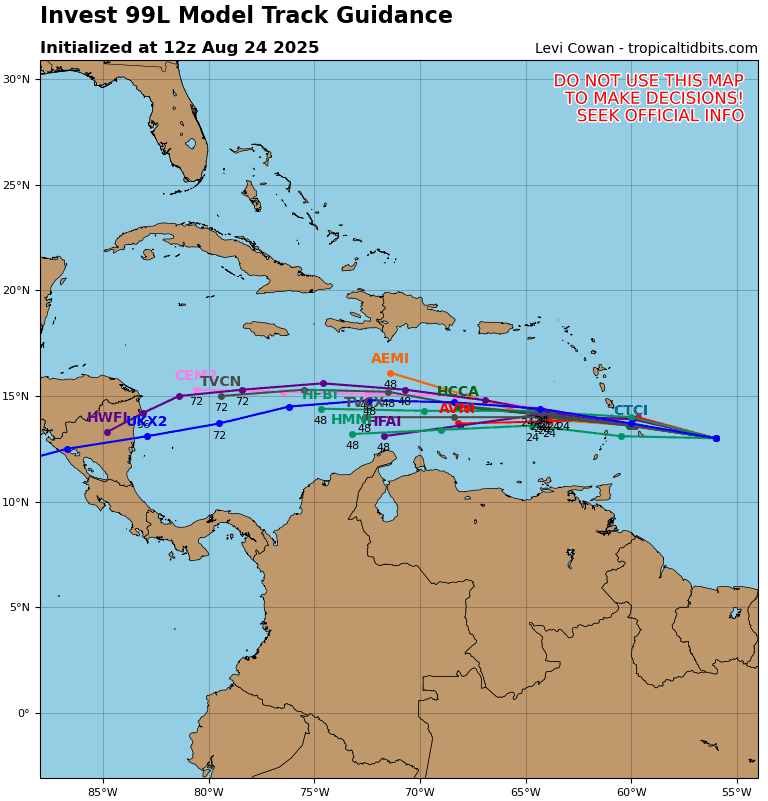Current Snapshot
For all the latest updates visit: DisasterAWARE
By PDC’s Senior Weather
Specialist Glenn James

The Pacific Disaster Center’s (PDC Global) Wednesday, September 25, 2024, Tropical Cyclone Activity Report for the Atlantic Ocean, the Caribbean Sea, and the Gulf of Mexico
CURRENT TROPICAL CYCLONES:
Tropical Cyclone 09L (Helene)…located about 425 miles southwest of Tampa, Florida
Tropical Cyclone 10L (Issac)…located about 690 miles east-northeast of Bermuda
>>> Eastern and Central Tropical Atlantic:
Invest 98L
Showers and thunderstorms have become slightly better organized over the past 24 hours in association with a broad low pressure system along a tropical wave located several hundred miles west of the Cabo Verde Islands. Environmental conditions appear favorable for gradual development of this system, and a tropical depression is likely to form during the next couple of days while it moves westward to west-northwestward across the eastern and central tropical Atlantic.
* Formation chance through 48 hours…high…70 percent
* Formation chance through 7 days…high…80 percent
Tropical Cyclone 09L (Helene)
HELENE STRENGTHENING…PREPARATIONS TO PROTECT LIFE AND PROPERTY FROM STORM SURGE AND DAMAGING WINDS ALONG THE FLORIDA BIG BEND COAST SHOULD BE RUSHED TO COMPLETION TODAY
According to the NHC Advisory number 10
Helene is moving toward the north near 12 mph (19 km/h). A northward or north-northeastward motion at a faster forward speed is expected during the next 36 hours. On the forecast track, Helene will move across the eastern Gulf of Mexico tonight and Thursday and cross the Florida Big Bend coast Thursday evening. After landfall, Helene is expected to turn northwestward and slow down over the Tennessee Valley on Friday and Saturday.
Maximum sustained winds are near 85 mph (140 km/h) with higher gusts. Strengthening is forecast, and Helene is expected to be a major hurricane when it reaches the Florida Big Bend coast Thursday evening. Weakening is expected after landfall, but Helene’s fast forward speed will allow strong, damaging winds, especially in gusts, to penetrate well inland across the southeastern United States, including over the higher terrain of the southern Appalachians.
Hurricane-force winds extend outward up to 25 miles (35 km) from the center and tropical-storm-force winds extend outward up to 345 miles (555 km).
HAZARDS AFFECTING LAND
RAINFALL: Helene is expected to produce total rain accumulations of 4 to 8 inches over western Cuba, the Cayman Islands, and the northeast Yucatan Peninsula, with isolated totals around 12 inches. This rainfall brings a risk of considerable flooding.
Over the Southeastern U.S. into the Southern Appalachians, Helene is expected to produce total rain accumulations of 5 to 10 inches with isolated totals around 15 inches. This rainfall will likely result in areas of considerable flash and urban flooding, with areas of significant river flooding. Landslides are possible in areas of steep terrain in the southern Appalachians.
STORM SURGE: The combination of a dangerous storm surge and the tide will cause normally dry areas near the coast to be flooded by rising waters moving inland from the shoreline. The water could reach the following heights above ground somewhere in the indicated areas if the peak surge occurs at the time of high tide…
Carrabelle, FL to Chassahowitzka, FL…10-15 ft
Chassahowitzka, FL to Anclote River, FL…6-10 ft
Indian Pass, FL to Carrabelle, FL…6-10 ft
Anclote River, FL to Middle of Longboat Key, FL…5-8 ft
Tampa Bay…5-8 ft
Middle of Longboat Key, FL to Englewood, FL…4-7 ft
Englewood, FL to Flamingo, FL…3-5 ft
Charlotte Harbor…3-5 ft
Storm surge could raise water levels by as much as 2 to 4 feet above normal tide levels in areas of onshore winds along the southern coast of Pinar del Rio, Cuba, including the Isle of Youth.
Storm surge could raise water levels by as much as 2 to 4 feet above ground level in areas of onshore winds within the warning area along the east coast of the Yucatan Peninsula.
WIND: Hurricane conditions are expected within the U.S. hurricane warning area late Thursday, with tropical storm conditions beginning Thursday morning. Tropical storm conditions are expected in southern Florida later today and will spread northward across the rest of Florida, Georgia, and South Carolina through Thursday. Tropical storm conditions are possible within the tropical storm watch area in South Carolina beginning on Thursday.
Hurricane conditions, especially in gusts, are expected in the hurricane warning area in Mexico during the next several hours. Tropical storm conditions are occurring in the warning area in Cuba, and hurricane conditions are possible for the western portion of Cuba today.
SURF: Swells generated by Helene will affect the southern coast of Cuba and the Yucatan Peninsula of Mexico during the next couple of days. Swells will spread northward toward the west coast of Florida and the northeastern Gulf Coast later today and Thursday. These swells are likely to cause life-threatening surf and rip current conditions.
TORNADOES: A tornado or two may occur tonight over parts of the Florida Peninsula and southern Alabama. The risk of tornadoes will increase on Thursday, expanding northward across Florida into parts of Georgia and South Carolina.
Tropical Cyclone 10L (Issac)
NEW TROPICAL STORM FORMS IN THE OPEN CENTRAL SUBTROPICAL ATLANTIC
According to the NHC Advisory number 1
Isaac is moving toward the east near 12 mph (19 km/h) and a general eastward to east-northeastward motion at a slightly faster speed is anticipated over the next several days.
Recent satellite wind data indicates that maximum sustained winds are near 50 mph (85 km/h) with higher gusts. Some strengthening is forecast during the next couple of days and Isaac could be near hurricane intensity by the end of the week.
Tropical-storm-force winds extend outward up to 220 miles (350 km) from the center.
HAZARDS AFFECTING LAND
SURF: Swells generated by Isaac and a large wind fetch from a
deep-layer trough are affecting portions of the coast of Bermuda and could spread into the Azores by this weekend. These swells are likely to cause life-threatening surf and rip current conditions.













